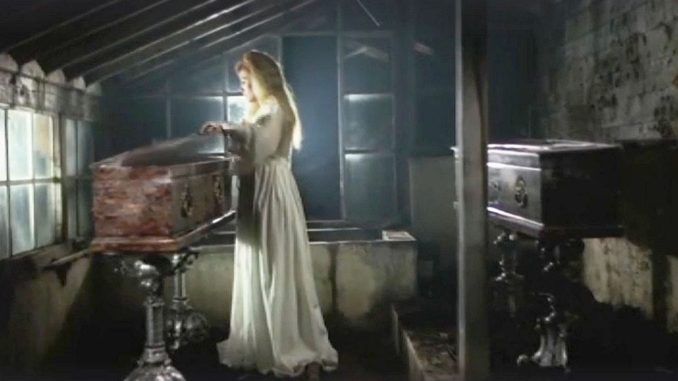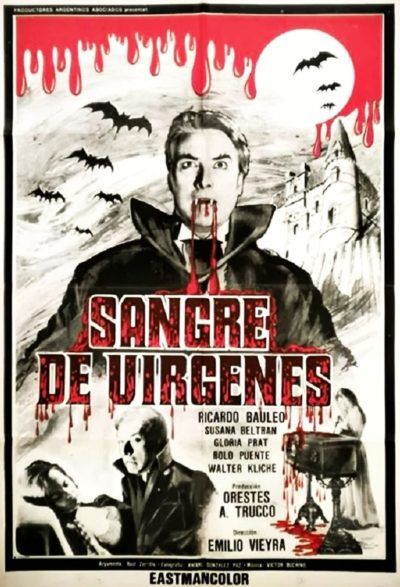
Rating: C-
Dir: Emilio Vieyra
Star: Rolo Puente, Susana Beltrán, Gloria Prat, Walter Kliche
a.k.a. Blood of the Virgins
Let the record show that the opening credits of this actually list a leading man’s name as Richard Baulex. Yes, this movie stars Mr. Baulex and Ms. Prat. I laughed like a drain at that. The IMDb goes with a different spelling; perhaps the confusion is because the print I was watching was in the original Spanish language, but for some reasons, the credits were in Italian. Hey, you take your moderately sleazy, sixties, Argentinian vampire movies where you can get them. This one starts off in the 19th century, with Ofelia (Beltrán) facing a dilemma. While she’s in love with Gustavo (Kliche), her family are keen for her to marry their choice, Eduardo. When Gustavo refuses to meet the parents, Ofelia dutifully marries Eduardo, only for Gustavo – who to nobody’s surprise, is a vampire – to show up, stab Eduardo dead and make Ofelia his bride.
Decent enough opening. The stabbing is bloody, and Beltran is… well, let’s just say, you understand why Gustavo aims slightly lower than Ofelia’s neck, if you know what I mean, and I think you do. There’s a weird but not unattractive animated credit sequence and we also get to see one of the film’s trademarks: footage of flying seagulls, shot through a red filter. The significance is never explained. It’s not as if Gustavo turns into one, and indeed, the whole thing appears to unfold high up in the mountains, rather than by the sea. I suspect Vieyra couldn’t find any bats to film, and decided one flying creature was just as good as any other. It does probably explain why Tubi chose to recommend Night of the Seagulls to me on this movie’s page.
 Anyway, the film then grinds to a complete halt. We’re now in the present day, where Raúl Aguilar (Puente) is on holiday in Bariloche with a bunch of pals. We know this, because we get a full six-minute, wordless montage of him being on holiday in Bariloche with a bunch of pals. This includes: snogging, a pleasure cruise, dancing, snogging, winter sports, dancing, general tourism, outdoor nookie, driving, red-filtered seagulls, snogging, and topless bar-dancing, where the cameraman appears to be auditioning for “everyday objects seen from unusual angles”: can you guess what it is yet? This is a sequence which, I’d estimate, runs five minutes and thirty seconds too long. Matters are not helped by the presence of a comic relief sidekick/tour guide, played by the film’s producer, Orestes Trucco. That other job is probably the only reason he didn’t get fired, because he has all the comic timing of a tooth abscess.
Anyway, the film then grinds to a complete halt. We’re now in the present day, where Raúl Aguilar (Puente) is on holiday in Bariloche with a bunch of pals. We know this, because we get a full six-minute, wordless montage of him being on holiday in Bariloche with a bunch of pals. This includes: snogging, a pleasure cruise, dancing, snogging, winter sports, dancing, general tourism, outdoor nookie, driving, red-filtered seagulls, snogging, and topless bar-dancing, where the cameraman appears to be auditioning for “everyday objects seen from unusual angles”: can you guess what it is yet? This is a sequence which, I’d estimate, runs five minutes and thirty seconds too long. Matters are not helped by the presence of a comic relief sidekick/tour guide, played by the film’s producer, Orestes Trucco. That other job is probably the only reason he didn’t get fired, because he has all the comic timing of a tooth abscess.
Goddammit, I’d better get on with the story, or this is going to turn into another Dracula: A Vampyre in Beijing-sized review. Fortunately, the plot is fairly thin. The party’s car runs out of fuel, the guide being as useless as he is unfunny. They seek shelter in a nearby residence, which turns out to be home to Gustavo and Ofelia. It’s a rather modern looking residence – a nice-looking log-cabin, rather than the Gothic castle typically occupied by vampires. Raul is seduced by and spends the night with Ofelia, waking the next morning to find all the women in the group missing. Naturally, the local authorities are no help, the police commissioner telling him, “That house has been empty for years!” One of the abductees, Laura (Ms. Prat), shows up at his window, but in a trance-like state, so he calls her brother Tito (the Baulex brother) to come up from Buenos Aires to help investigate.
Meanwhile, Ofelia is forever wandering the woods in her Gothic Nightie™, and this is the crux of the plot. It turns out she’s more than slightly fed up of the whole “eternal life” thing in general, and Gustavo in particular, which is why she’s flinging herself at any red-blooded male with a pulse who crosses her path. This is actually quite effective and poignant: if the film had stuck with this theme, it could have ended up being an nice little story of love found and lost. However, it makes much the same mistake as Dracula A.D. 1972 would a few years later. This attempts to get all “How do you do, fellow kids?” and include a bunch of young people who are mostly irritating, and almost entirely irrelevant. Indeed, Raúl’s main purpose seems to be to come between the audience and what they want: a good look at Ofelia’s rack.
 These hip elements were likely not helped by the movie’s initial release being delayed by several years; the five further decades which have passed render it about as contemporary as a hip replacement. I strongly suspect nobody in the entire movie is a virgin either, despite the title. Director Vieyra is best known for a film he directed a couple of years later, La venganza del sexo, with quite a few of the same cast. It was padded with 17 additional minutes of gratuitous nudity by the American distributors, and released with the all-time classic exploitation title, The Curious Doctor Humpp. 17 additional minutes of Ms. Beltrán would probably not have been a bad thing; I’d trade that for 17 fewer minutes of young people on holiday, or even those red-filtered seagulls.
These hip elements were likely not helped by the movie’s initial release being delayed by several years; the five further decades which have passed render it about as contemporary as a hip replacement. I strongly suspect nobody in the entire movie is a virgin either, despite the title. Director Vieyra is best known for a film he directed a couple of years later, La venganza del sexo, with quite a few of the same cast. It was padded with 17 additional minutes of gratuitous nudity by the American distributors, and released with the all-time classic exploitation title, The Curious Doctor Humpp. 17 additional minutes of Ms. Beltrán would probably not have been a bad thing; I’d trade that for 17 fewer minutes of young people on holiday, or even those red-filtered seagulls.
There is some good stuff here: the photography is nice, and the imagery occasionally striking, as the pictures in this article should illustrate. Also: this part of Argentina looks surprisingly like Switzerland, so if this was funded by the Bariloche Tourist Board, it was money well spent. However, even at 75 minutes long, there’s just too much which would benefit from being cut, and Gustavo has to rank among the least memorable of cinematic vampires – and that’s discounting the obviously plastic fangs. The somewhat surprising degree of raunch for the time can only take a movie so far. Especially when it largely discards the strongest elements, instead concentrating on the least interesting ones.
This review is part of our October 2023 feature, 31 Days of Vampires.
